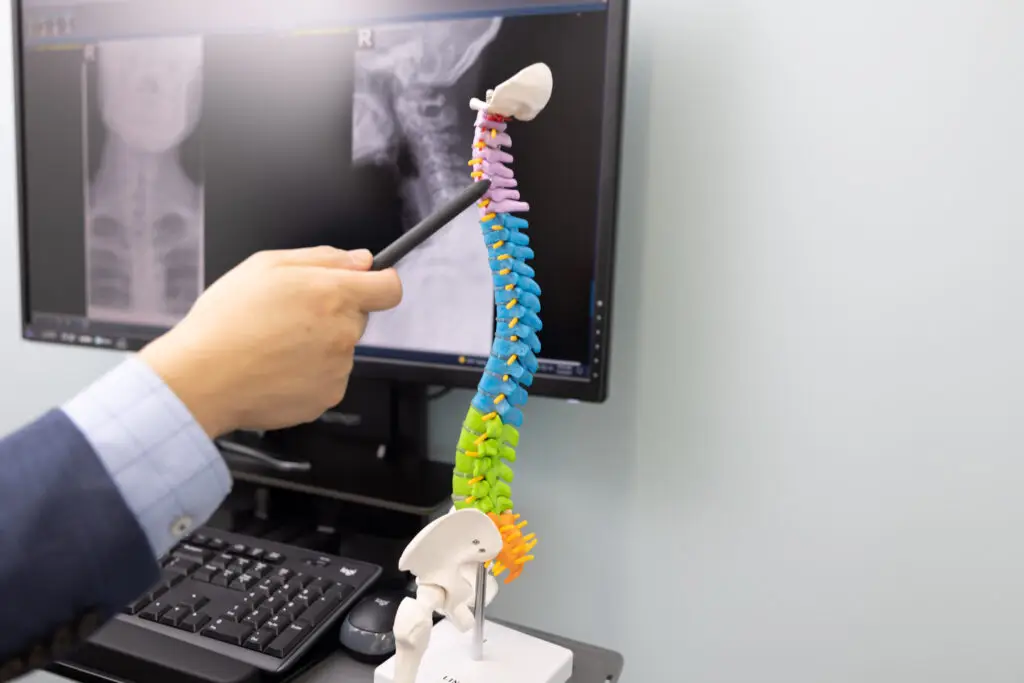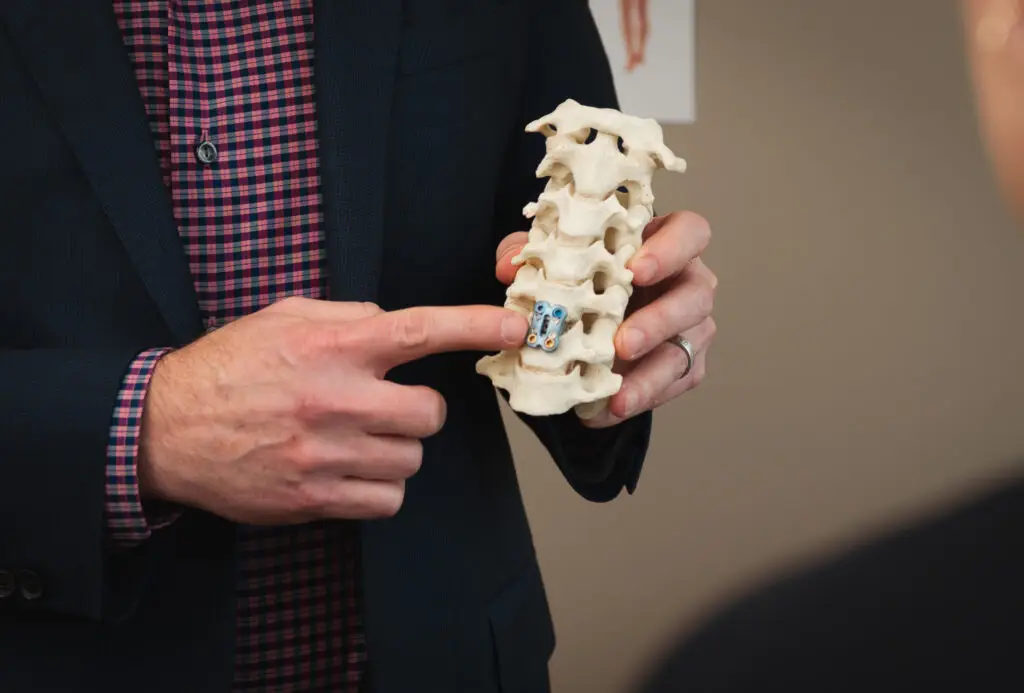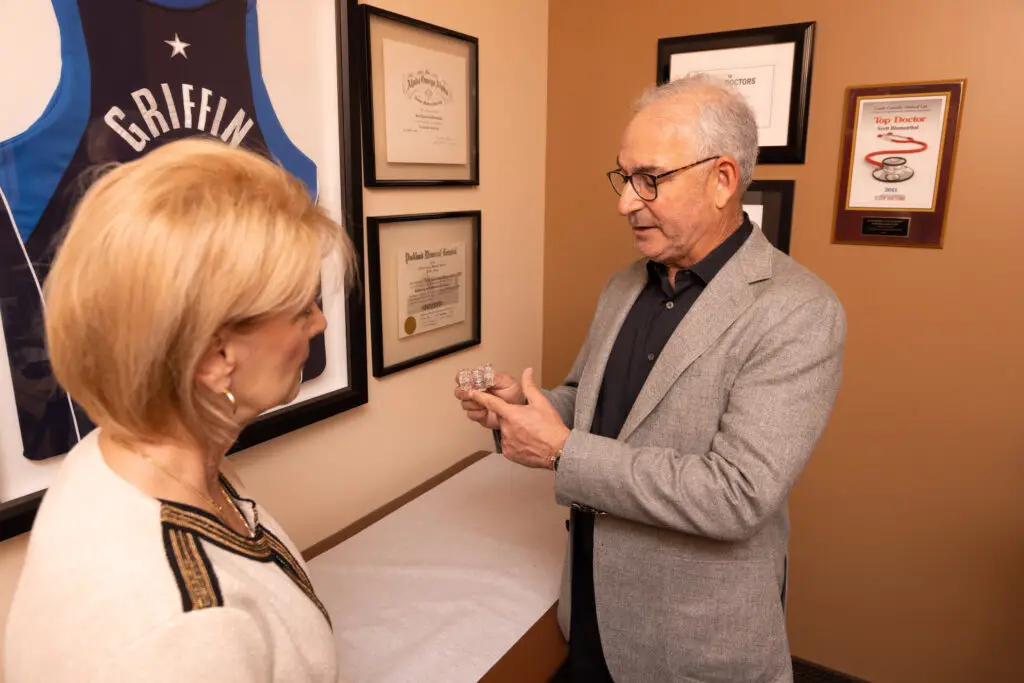DEXA Scan: What You Need to Know About Bone Density Scans
(Insert illustration suggesting the DEXA Scan)
how we can help
DEXA Scan Overview
A bone density scan, often called a bone density test or a DEXA scan, is a medical test that uses X-rays to measure the calcium and mineral content in bones, usually targeting areas like the spine, hip, or forearm.
This test is important for diagnosing conditions such as osteoporosis, where bones become fragile and more susceptible to fractures, and osteopenia, which indicates lower-than-normal bone density that is not severe enough to be classified as osteoporosis. By assessing bone density, doctors can evaluate the risk of fractures and monitor the effectiveness of treatments for bone-related conditions.
A DEXA scan is recommended for women over 65 and men over 70, as well as individuals over 50 who’ve experienced fractures, have a family history of osteoporosis, have lost height, or are on long-term steroid medications.
During the procedure, which is quick and painless, an individual lies on a table while a scanner passes over their body, emitting low-dose X-rays to measure bone density. The results are analyzed using a T-score that compares their bone density to that of a healthy young adult.
Table of Contents
Symptoms of Low Bone Mineral Density
Diagnosing Low Bone Mineral Density
Treatments for Low Bone Mineral Density
Patients Ask:
What is a T-score?
Texas Back Institute Responds: A T-score is a baseline measure used during bone density scans. It is a comparison of a patient’s bone density to that of a healthy, young adult around 30 years old. This score is expressed in standard deviations, illustrating how much the patient’s bone density varies from the average baseline of this reference group.
Understanding T-scores in Your DEXA Scan
A doctor will assess a patient’s T-score along with other risk factors to evaluate their overall fracture risk and determine the best course of treatment or other necessary lifestyle adjustments.
The lower a T-score falls below zero, the greater the reduction in bone density and the greater the risk of experiencing fractures.
- T-score of -1.0 or higher: Indicates normal bone density.
- T-score between -1.0 and -2.5: Suggests osteopenia, which is lower than normal bone density but not yet at the level of osteoporosis.
- T-score of -2.5 or lower: Diagnoses osteoporosis, a condition marked by fragile bones and an elevated risk of fractures.

T-score chart
Patients Ask:
If my T-score is -2.5 or lower, is it conclusive that I have osteoporosis?
Texas Back Institute Responds: If a T-score is in that range, it is a strong indicator of the condition. A diagnosis of osteoporosis is typically confirmed by your doctor who will consider your T-score along with other variables, such as your medical history, risk factors, and additional tests.

Image of older woman dealing with osteoporosis or talking to doctor
Women and Osteoporosis
There are several factors that make women more vulnerable to developing osteoporosis themselves, especially as they age. They are:
- Estrogen Levels: Estrogen plays a crucial role in preserving bone density by inhibiting the natural breakdown of bone tissue. However, during menopause, there is a sharp decline in estrogen levels, which results in a rapid loss of bone mass.
- Bone Structure: Women typically have finer, smaller bone structures compared to men, which makes them more prone to experiencing bone loss.
- Earlier Bone Loss: Women often begin experiencing bone density loss earlier than men, typically starting in their 30s, whereas men generally encounter significant bone loss later in life.
- Menopause: Menopause is a leading cause of osteoporosis in women, as the hormonal changes during this time result in increased bone resorption (breakdown) without a corresponding increase in bone formation.
It’s important for women to monitor their bone health and take preventive measures, like maintaining a healthy diet rich in calcium and vitamin D, engaging in weight-bearing exercises, and discussing bone health with their doctor.
Patients Ask:
How often should women have a bone density scan?
Texas Back Institute Responds: Women who are postmenopausal and 65 or older should typically have a bone density scan every two years. However, the recommended frequency can vary depending on individual risk factors and past bone density test results. For instance, those with moderate osteopenia might only need a scan every five years, while women with more advanced osteopenia may require annual screenings.
Diagnostic Testing
A spinal surgeon might request a bone density scan if they think osteoporosis, bone fracture, or low bone density is causing a patient’s back issues. This is especially necessary if the patient has:
- Fragility fractures: Small spinal fractures that occur with minimal injury.
- Height loss: This could signal compression fractures in the vertebrae.
- Long-term steroid use: Medications like prednisone can weaken bones.
- Past spinal problems: Used to evaluate bone health before surgeries such as spinal fusion.

(insert photo of TBI physician consulting with a patient)

image related to one of these spinal conditions
Spinal Conditions Related to Low Bone Density
Besides osteoarthritis and osteoporosis, low bone mineral density can lead to several other spinal conditions, such as:
- Vertebral Compression Fractures: These fractures occur when weakened vertebrae break under pressure, causing severe back pain and deformity.
- Scoliosis: Reduced bone density can increase the risk of spinal curvature, especially in older adults.
- Proximal Junctional Kyphosis (PJK): This condition involves abnormal forward curvature of the spine just above a spinal fusion site.
- Pseudarthrosis: A lack of proper healing or nonunion after spinal surgery, which can be more common in patients with low bone density.
- Screw-Related Complications: Low bone density can lead to issues with screws used in spinal surgeries.
- Cage Subsidence: This occurs when the intervertebral cage used in spinal fusion surgery sinks into the adjacent vertebrae due to weak bones.
Patients Ask:
Are there alternative therapies that are available for patients with low bone mineral density?
Texas Back Institute Responds: For individuals with low bone density, there are several alternative therapies available to address spinal issues. Endoscopic spine surgery is a minimally invasive procedure using small incisions and specialized tools to treat spinal conditions. Epidural steroid injections (ESIs) can alleviate pain and inflammation in the spine, while artificial disc replacement involves substituting a damaged disc with an artificial one to maintain mobility and reduce discomfort.
DEXA Scan Procedure
A DEXA scan, or dual-energy X-ray absorptiometry, is a simple, painless test used to measure bone density. To prepare, patients generally do not need to make any changes to their daily routine but might be asked to stop taking calcium supplements a day before the scan.
Upon arrival, a patient changes into a gown and removes any metal objects. During the scan, they lie on a padded table while the technician positions them to ensure the targeted area, usually the lower spine and hips, is properly aligned.
The scanner will then pass over the body, emitting low-dose X-rays. The scan itself only takes about 10-15 minutes, and it’s important for a patient to remain still during this time.
After the bone scan is done, patients can resume normal activities. This procedure is noninvasive and uses minimal radiation, making it a safe and effective method for evaluating bone health.
Common Causes
Understanding the most common causes of low bone mineral density is fundamental for maintaining overall bone health and preventing related complications. Some key factors that contribute to this condition include:
- Aging: As we age, our bones naturally lose density, especially after age 30.
- Hormonal Changes: Menopause in women leads to a drop in estrogen levels, which can accelerate bone loss.
- Poor Nutrition: A diet low in calcium and vitamin D can negatively impact bone health.
- Lack of Physical Activity: Regular exercise is central to maintaining bone density.
- Medical Conditions: Conditions like hyperthyroidism, diabetes, and chronic kidney disease can contribute to bone loss.
- Medications: Long-term use of corticosteroids and certain other medications can weaken bones.
- Lifestyle Factors: Smoking and excessive alcohol consumption are known to reduce bone density.
- Genetic Factors: A family history of osteoporosis can increase the risk of low bone mineral density.

(insert photo of bad food diet)
Lifestyle Factors and Low Bone Mineral Density
Lifestyle choices such as smoking and heavy alcohol consumption can significantly impact bone density.
Smoking introduces nicotine and other harmful substances into the body that hinder calcium absorption, a critical mineral for bone strength. It also reduces blood flow to the bones, depriving them of necessary nutrients, and alters the activity of bone cells by decreasing osteoblasts (cells that form new bone) and increasing osteoclasts (cells that break down bone).
Excessive alcohol intake disrupts the balance of calcium and vitamin D, essential for maintaining healthy bones. It negatively affects hormone levels, reducing estrogen in women and raising cortisol and parathyroid hormone levels, which can lead to bone breakdown.
Together, these lifestyle factors weaken the bones, making them more susceptible to fractures. Quitting smoking and moderating alcohol consumption are important steps toward improving bone health and reducing the risk of bone fractures and osteoporosis.
Patients Ask:
Is a DEXA Scan used to diagnose cancer or anything else besides bone mineral density?
Texas Back Institute Responds: In addition to measuring bone mineral density, a DEXA scan can also assess body composition, providing information on the percentage of lean muscle and fat in the body. This makes it a valuable tool for diagnosing and monitoring conditions like malabsorption and for tracking changes in body composition over time. A DEXA Scan is not commonly used to diagnose conditions like bone cancer. For diagnosing bone cancer, more detailed imaging tests like X-rays, MRI, or CT scans are used to get a clearer picture of the bone structure and identify any suspicious areas.

image of strength training
Treatment for Low Bone Mineral Density
Doctors typically address low bone mineral density through a combination of lifestyle changes, supplements, and medications. Lifestyle adjustments are a key part of treatment, with physical therapists often recommending regular weight-bearing and muscle-strengthening exercises to bolster bone health. Additionally, quitting smoking and reducing alcohol consumption are vital steps to improving low bone mass density.
Supplements also play a key role, particularly calcium and vitamin D, which are essential for maintaining strong bones. Ensuring adequate intake of these nutrients can help counteract bone loss. In addition to supplements, a doctor may prescribe medications to slow or halt bone deterioration.
Preventing falls is another important aspect of managing low bone density, as falls can lead to fractures in individuals with weakened bones. Implementing measures to lessen broken bones and prevent falls helps protect bone health and overall well-being.
Patients Ask:
How do weight-bearing and muscle strengthening exercises improve bone health?
Texas Back Institute Responds: Weight-bearing exercises improve bone density by applying stress to the bones through activities that require your body to work against gravity. When you perform weight-bearing exercises, such as walking, running, or resistance training, the stress placed on the bones stimulates bone-forming cells called osteoblasts. These cells produce new bone tissue, increasing bone density and strength. Muscles pulling on the bones during exercise also plays a role in bone health. As muscles contract and exert force on the bones, this mechanical load encourages the bones to adapt and become denser.
Treatment Time Frame
The time frame to see improvement after starting treatment for low bone density varies from person to person and depends on the specific treatment plan. Most people start to notice improvements within three to five years of beginning treatment. However, it’s important to stick to the prescribed treatment and have regular follow-ups with your physician, as ongoing treatment may be needed to maintain bone health and prevent further bone loss.
Advancements in DEXA Scans: Beyond Bone Mineral Density
In the field of medical diagnostics, DEXA scans have long been considered the “gold standard” for measuring bone mineral density (BMD). Today, recent advancements are expanding its capabilities and provide even greater insights into bone health.
One of the most exciting developments is the Trabecular Bone Score (TBS). Unlike traditional BMD measurements, TBS offers an indirect assessment of the trabecular microarchitecture, referring to the tiny, intricate structures within the spine’s bones. This additional data allows physicians to predict fracture risk more accurately, giving a more detailed picture than using bone density measurements alone.
Another innovative use of DEXA technology is Vertebral Fracture Assessment (VFA). This technique can be performed during a standard DEXA scan and is designed to detect vertebral fractures that might otherwise go unnoticed. By identifying these fractures early, physicians can intervene faster, potentially preventing further bone damage and improving patient outcomes.
Impact Microindentation (IMI) is a newer technique that measures the bone’s material strength by assessing how well it can resist cracks and fractures. This method involves a small probe that indents the surface of the tibial bone cortex, providing valuable data on the bone’s ability to withstand mechanical stress. IMI adds another layer of information, helping doctors understand the nuances of bone strength beyond what traditional BMD scores can offer.
The evolution of DEXA scans underscores the importance of continuous innovation in medical diagnostics. By expanding the utility of this already valuable tool, physicians are better equipped to address the complexities of bone health. These advancements not only improve diagnostic accuracy but also contribute to more personalized and effective patient care.
What's Next?
If you have concerns about your bone health or believe you might be at risk for low bone mineral density, don’t wait. Scheduling an appointment for further evaluation can provide you with the information and care you need.
Learn more
Frequently Asked Questions
A T-score is a baseline measure used during bone density scans. It is a comparison of a patient’s bone density to that of a healthy, young adult around 30 years old. This score is expressed in standard deviations, illustrating how much the patient’s bone density varies from the average baseline of this reference group.
If a T-score is in that range, it is a strong indicator of the condition. A diagnosis of osteoporosis is typically confirmed by your doctor who will consider your T-score along with other variables, such as your medical history, risk factors, and additional tests.
Women who are postmenopausal and 65 or older should typically have a bone density scan every two years. However, the recommended frequency can vary depending on individual risk factors and past bone density test results. For instance, those with moderate osteopenia might only need a scan every five years, while women with more advanced osteopenia may require annual screenings.
For individuals with low bone density, there are several alternative therapies available to address spinal issues. Endoscopic spine surgery is a minimally invasive procedure using small incisions and specialized tools to treat spinal conditions. Epidural steroid injections (ESIs) can alleviate pain and inflammation in the spine, while artificial disc replacement involves substituting a damaged disc with an artificial one to maintain mobility and reduce discomfort.
In addition to measuring bone mineral density, a DEXA scan can also assess body composition, providing information on the percentage of lean muscle and fat in the body. This makes it a valuable tool for diagnosing and monitoring conditions like malabsorption and for tracking changes in body composition over time. A DEXA Scan is not commonly used to diagnose conditions like bone cancer. For diagnosing bone cancer, more detailed imaging tests like X-rays, MRI, or CT scans are used to get a clearer picture of the bone structure and identify any suspicious areas.
Weight-bearing exercises improve bone density by applying stress to the bones through activities that require your body to work against gravity. When you perform weight-bearing exercises, such as walking, running, or resistance training, the stress placed on the bones stimulates bone-forming cells called osteoblasts. These cells produce new bone tissue, increasing bone density and strength. Muscles pulling on the bones during exercise also plays a role in bone health. As muscles contract and exert force on the bones, this mechanical load encourages the bones to adapt and become denser.
Locations


